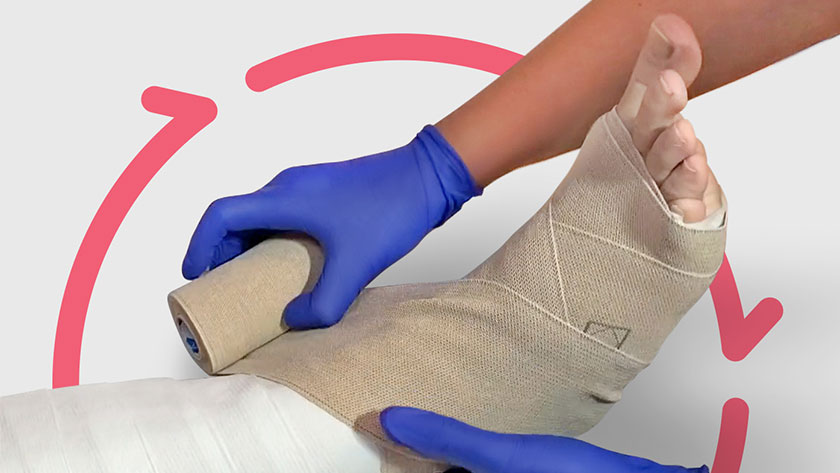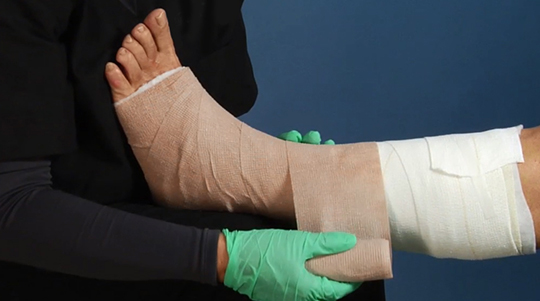Use this chart to choose the right compression wrap for legs
Select the right treatment for people with chronic venous insufficiency.

Chronic venous insufficiency (CVI) affects approximately 2.5 million people in the United States.1 It’s typically caused by venous walls or valves failing to move blood adequately back to the heart from the legs, and it can result in blood pooling in the lower extremities. This leads to a buildup of pressure and swelling, which can cause fluid and blood to leak out of veins, creating a risk for developing venous leg ulcers or venous stasis.
About 20 percent of people with CVI develop venous stasis.1 From poor blood flow and painful swelling to dry, itchy skin and hard-to-heal wounds, venous stasis is a life-long disease that requires ongoing treatment—and a willingness from patients to practice self-care.
How do you treat venous stasis? First, it’s important to measure a patient’s ankle brachial index to rule out arterial ulcers. Once that’s been done, compression therapy is considered the gold standard for treatment aimed at improving blood flow in the leg veins.
Compression wraps for legs help:
- Return blood flow from the leg back to the heart
- Restore normal pressure in the superficial veins
- Prevent and reduce edema by forcing fluid back into the capillaries
- Manage venous leg wounds
- Prevent further venous stasis and deterioration of venous walls
- Relieve aching and heavy leg
- Increase blood flow to the skin

“Compression is used to bring the body into homeostasis, the word for body balance.”
— Robyn “Redd” Smith M.Ed., COTA/L, CLWT, CLT, a Medline consultant
"Compression is used to bring the body into homeostasis, the word for body balance,” says Robyn “Redd” Smith M.Ed., COTA/L, CLWT, CLT, a Medline consultant. Smith says even physicians may believe that compression is used to squeeze fluid out. In fact, compression is done to balance pressure, to “replace the natural function of the body.”
Smith draws on the analogy of a leak in a garden hose. “If you put your finger against the hole lightly, it will still leak, but if you push against it with equal and opposite pressure, the leak will stop.”
The balancing of pressure forms the basis of compression and helps with problem veins and when leg valves don't work. Learn how to select compression that fits your patient’s needs.
There are many compression wraps and compression garments available, and it can be confusing to know which one is right for your patient. Here, we provide a reference chart to help simplify the decision-making process. Before using compression as treatment for chronic venous insufficiency or venous leg ulcers, be sure you know the patient’s ankle brachial index (ABI) to determine whether compression is safe.

- Typically applied by the clinician
- Cohesive compression layer keeps it in place
- AccuWrap and AccuWrap XL provide 30-40 mmHg of therapeutic compression
- AccuWrap Lite provides 20-30 mmHg of therapeutic compression
- Wear time* up to 7 days
- Accuracy indicator
- Absorbent padding bandage layer conforms to bony prominences
- Easy and consistent application by clinician
- Extra-long kit available
- Low profile fits under clothes and in shoes

- TwoFlex provides 30-40 mmHg of therapeutic compression
- Two-Flex Lite provides 20-30 mmHg of therapeutic compression
- Wear time* up to 7 days
- Comfortable foam padding layer encourages patient compliance
- Cohesive compression layer keeps it in place
- Easily torn by hand
- Inexpensive upfront cost
- Extra-long kit available

- Best for ongoing management of chronic venous insufficiency
- Provides 20-30, 30-40 or 40-50 mmHg of therapeutic compression
- Liner sock provides 10-15 mmHg of therapeutic compression
- Customized compression with ACCUTAB®
- Easy application and removal
- Moisture-wicking material helps with patient comfort
- Each pack includes 2 reusable socks that last up to six months
- Extra-long kit available
- Low profile fits under clothes and shoes

- 3-layer provides 20-30 mmHg of therapeutic compression
- 4-layer is best for managing chronic venous insufficiency and provides 30-40 mmHg of therapeutic compression
- Wear time* up to 7 days
- Inexpensive upfront cost
- FourFlex layers provide cushioning, absorbency, conformed wrapping and stability for the system to stay in place
- FourFlex is available in an extra-long kit

- Improves circulation and helps manages edema
- Wear time* during waking hours
- Can be stretched to fit most leg shapes
- Gradient pressure for more patient comfort
- Nylon and Spandex blend offers strength and stretch

- Manages venous leg ulcers in ambulatory patients
- Unna-Z Stretch offers greater elasticity for easier application and conformability
- Wear time* up to 7 days
- Inexpensive upfront cost
- Disposable, inelastic bandage
- Soothes skin with impregnated zinc oxide (with or without calamine)
- Semi-rigid support
- Inner plastic core eases application
* Wear time will often depend on the amount of drainage from the wound. See packaging for more information.
Patient adherence to treatment is key
Effective compression therapy starts in a clinical setting, but continues at home, allowing patients to take more control of their symptoms. The challenge is that compression garments may be uncomfortable to wear. They can also be difficult for patients to put on and take off themselves, especially for elderly patients, which may cause them to give up completely.
Read about 3 ways to help patients understand their role in managing their venous stasis disease.
Remember that you can improve outcomes for patients with venous stasis by using a system of products: compression therapy combined with gentle, moisturizing skin care and advanced wound care. This holistic strategy can help control venous stasis symptoms and improve quality of life.
Key takeaway
It’s important to educate yourself and your patients about how to manage venous stasis disease. Choosing the right compression therapy is a crucial part of this process. Share this chart with your staff so they can help find the right compression therapy for patient symptoms.
References:
- Eberhardt, R. T., & Raffetto, J. D. (2014). Chronic Venous Insufficiency. Circulation, 130(4), 333–346. https://doi.org/10.1161/circulationaha.113.006898. Available at https://www.ahajournals.org/doi/full/10.1161/CIRCULATIONAHA.113.006898
- Rice, J. B., Desai, U., Cummings, A. K. G., Birnbaum, H. G., Skornicki, M., & Parsons, N. (2014). Burden of venous leg ulcers in the United States. Journal of Medical Economics, 17(5), 347–356. https://doi.org/10.3111/13696998.2014.903258. Available at https://pubmed.ncbi.nlm.nih.gov/24625244/




